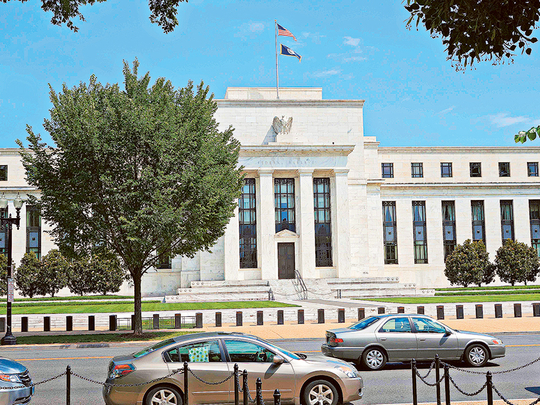
New York: Wall Street is pushing back against the Federal Reserve’s tougher tone on raising interest rates, as strategists see the bond market warning of potential consequences.
Treasuries staged their biggest weekly decline since November after minutes from the Fed’s April meeting rekindled wagers that policymakers will raise rates as soon as next month. The dollar soared and bond-market gauges of inflation expectations fell. What’s more, traders started betting the gap between two- and 10-year note yields will narrow over the next three years, after it reached the flattest since 2007 this week.
That means Fed officials may get “dangerously close to the market pricing in inverted yield curves, two to three years forward,” Bank of America Merrill Lynch analysts led by Shyam Rajan wrote in a Friday note. An inversion of the yield curve, which occurs when short-term rates rise above longer-term rates, is seen as a harbinger of recession. As a result, bond traders are “reigniting the policy mistake trade,” or the view that the officials will tamp down growth by raising rates too quickly.
Fed outlook
“The market is treating the recent shift in Fed communications as a mistake,” Rajan said in an interview Friday.
The analysts said traders should bet 10-year Treasuries will yield just a quarter percentage point more than two-year debt in three years, using derivatives known as forward swaps. Those derivatives prices indicate traders expect the yield gap will be cut in half in the next three years, to 47 basis points from 96 on Friday. The last time two-year yields were higher than 10-year yields was in the first half of 2007, before the global financial crisis.
Two Fed officials said on May 17 that at least two rate increases would be possible in 2016. Minutes from the April policy meeting released a day later showed most officials said a move in June would be warranted if economic growth and inflation strengthen. That sparked a 14-basis-point advance in 10-year yields this week, the most since the week ended Nov. 6.
The price of the 1.625 per cent security maturing in May 2026 fell 1 1/4, or $12.50 (Dh46) per $1,000 face amount, to 98 2/32.
Traders are betting there’s a 30 per cent chance officials raise rates at their June meeting, up from 7 per cent a week ago, according to Bloomberg overnight-indexed swaps data. The implied forward fed funds rate for the end of 2016 rose to 0.64 per cent, up from 0.51 per cent a week earlier.
Economic strength
Yet Rajan’s biggest worry is where traders see interest rates going in years, not months. The bank says traders may start betting the Fed won’t be able to raise rates as far as they previously expected in coming years.
One reason is that a bond-market gauge of inflation expectations has declined, showing traders don’t see a pickup in economic growth that would prompt the Fed to quicken its pace of hikes. The 10-year break-even rate, which measures the gap between yields on Treasury Inflation-Protected Securities and nominal securities, dropped to 1.60 percentage points Friday from 1.71 percentage points on May 2.
The Commerce Department is forecast to report May 27 that gross domestic product rose at a revised 0.9 per cent annualised pace in the first quarter, and that a gauge of consumer price growth rose at a 2.1 per cent pace, according to the median estimates in a Bloomberg survey of economists. The most recent first-quarter data fell short of economist forecasts, indicating the US economy expanded at a 0.5 per cent annualised pace, below the median estimate of 0.7 per cent.
“The market’s looking at the data and saying, you don’t need to hike,” said Lee Ferridge, the Boston-based head of macro strategy at State Street Global Markets. “I don’t think they’ve got the room to hike. Maybe, but I don’t think the economy’s strong enough.”












